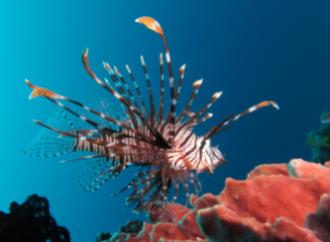Landmark scientific study published by Frontiers in Marine Science journal

Credit: Prof. Alan Deidun
A landmark scientific study involving marine biologists from Greece, Turkey, Cyprus, Libya, Italy, Tunisia, the UK, the US and even Malta, documenting instances where native Mediterranean species have preyed upon two highly invasive marine fish – the Pacific red lionfish and the silver-cheeked toadfish – has just been published. Prof. Alan Deidun, coordinator of the Spot the Alien Fish citizen science campaign and resident academic within the Department of Geosciences of the Faculty of Science, is a co-author of such an extensive study.
The Pacific red lionfish (Pterois miles) and the silver-cheeked toadfish (Lagocephalus sceleratus) are amongst the most invasive of non-indigenous fish species to enter the Mediterranean in recent years, posing both ecological and socio-economic hazards. For instance, considerable negative impacts on native fish populations in the Caribbean and in the Gulf of Mexico has been recorded as a result of the introduction of non-native lionfish species, such that the active removal and even consumption of the species is advocated by conservation biologists in the invaded areas, mainly as a result of a lack of predators of the same species. In addition, lionfish also pose risks to humans as the venom in their 18 spines can cause cardiovascular and neuromuscular effects, ranging from mild reactions, including swelling, to extreme pain and paralysis in upper and lower extremities. The Pacific red lionfish was first recorded from the Mediterranean in 1991 within Israeli waters, having reached the central Mediterranean in Italy and in Tunisia, but not Maltese waters, to date.
The silver-cheeked toadfish was first recorded from the Mediterranean from Turkish waters in 2003, and has even been caught a number of times from Maltese waters as of 2016. This is an extremely toxic species due to the high concentrations of the potent neurotoxin tetrodotoxin (TTX) it harbours in its tissues, responsible for a number of human mortalities each year. In addition, the species disrupts fishing lines, tears fishing nets and predates on fished stocks, including cephalopods (squid, cuttlefish, octopus), wreaking a considerable socio-economic impact.
The study has documented only one native predator of adult silver-cheeked toadfish – loggerhead turtles – and a number of native predators for juvenile toadfish, including dolphinfish (lampuki) and garfish (msell). Interestingly enough, cannibalism was also observed within the species. As for the Pacific red lionfish, documented native predators included the dusky grouper (?erna), the white grouper (dott tal-faxxi), the common octopus (qarnit) as well as the silver-cheeked toadfish itself. The study also documented predation of the two invasive fish species within their native range (i.e. Indo-Pacific region) as well as from other invaded regions (e.g. western Atlantic), through a trans-Atlantic research collaboration with colleagues from the US.
The relative paucity in natural, native predators of these two highly invasive non-indigenous fish species suggests that direct human management measures need to be implemented in order control their Mediterranean populations. In Cyprus, for example, the direct removal of both silver-cheeked toadfish and Pacific red lionfish individuals is incentivised by authorities through the provision of financial ‘bounties’ and through the organisation of spearfishing competitions known as ‘derbies.’
###
The study has been published in the high-impact Frontiers in Marine Science journal and can be accessed freely online: https:/
Media Contact
Prof. Alan Deidun
[email protected]
Original Source
https:/
Related Journal Article
http://dx.




